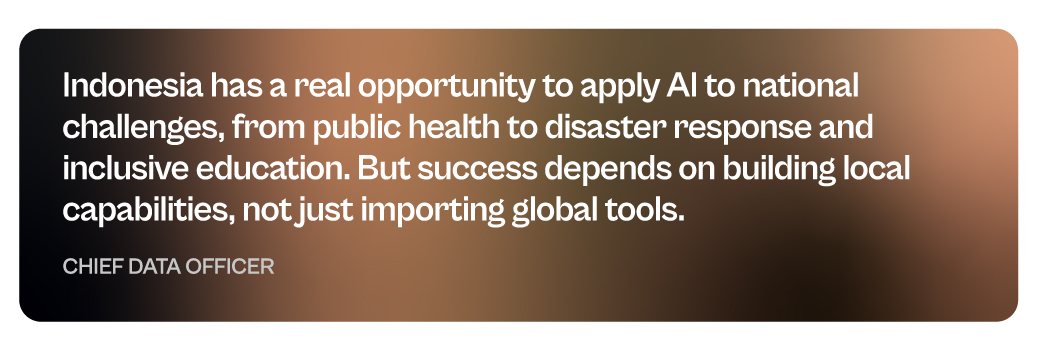Indonesia’s vast, diverse population and scattered islands create a unique landscape for AI adoption. Across sectors – from healthcare to logistics and banking to public services – leaders view AI not just as a tool for efficiency but as a means to expand reach, build resilience, and elevate citizen experience. With AI expected to add up to 12% of Indonesia’s GDP by 2030, it’s poised to be a core engine of growth.
Yet, ambition isn’t enough. While AI interest is high, execution is patchy. Many organisations remain stuck in isolated pilots or siloed experiments. Those scaling quickly face familiar hurdles: fragmented infrastructure, talent gaps, integration issues, and a lack of unified strategy and governance.
Ecosystm gathered insights and identified key challenges from senior tech leaders during a series of roundtables we moderated in Jakarta. The conversations revealed a clear picture of where momentum is building – and where obstacles continue to slow progress. From these discussions, several key themes emerged that highlight both opportunities and ongoing barriers in the country’s digital journey.
Theme 1. Digital Natives are Accelerating Innovation; But Need Scalable Guardrails
Indonesia’s digital-first companies – especially in fintech, logistics tech, and media streaming – are rapidly building on AI and cloud-native foundations. Players like GoTo, Dana, Jenius, and Vidio are raising the bar not only in customer experience but also in scaling technology across a mobile-first nation. Their use of AI for customer support, real-time fraud detection, biometric eKYC, and smart content delivery highlights the agility of digital-native models. This innovation is particularly concentrated in Jakarta and Bandung, where vibrant startup ecosystems and rich talent pools drive fast iteration.
Yet this momentum brings new risks. Deepfake attacks during onboarding, unsecured APIs, and content piracy pose real threats. Without the layered controls and regulatory frameworks typical of banks or telecom providers, many startups are navigating high-stakes digital terrain without a safety net.
As these companies become pillars of Indonesia’s digital economy, a new kind of guardrail is essential; flexible enough to support rapid growth, yet robust enough to mitigate systemic risk.
A sector-wide governance playbook, grounded in local realities and aligned with global standards, could provide the balance needed to scale both quickly and securely.

Theme 2. Scaling AI in Indonesia: Why Infrastructure Investment Matters
Indonesia’s ambition for AI is high, and while digital infrastructure still faces challenges, significant opportunities lie ahead. Although telecom investment has slowed and state funding tightened, growing momentum from global cloud players is beginning to reshape the landscape. AWS’s commitment to building cloud zones and edge locations beyond Java is a major step forward.
For AI to scale effectively across Indonesia’s diverse archipelago, the next wave of progress will depend on stronger investment incentives for data centres, cloud interconnects, and edge computing.
A proactive government role – through updated telecom regulations, streamlined permitting, and public-private partnerships – can unlock this potential.
Infrastructure isn’t just the backbone of digital growth; it’s a powerful lever for inclusion, enabling remote health services, quality education, and SME empowerment across even the most distant regions.

Theme 3. Cyber Resilience Gains Momentum; But Needs to Be More Holistic
Indonesian organisations are facing an evolving wave of cyber threats – from sophisticated ransomware to DDoS attacks targeting critical services. This expanding threat landscape has elevated cyber resilience from a technical concern to a strategic imperative embraced by CISOs, boards, and risk committees alike. While many organisations invest heavily in security tools, the challenge remains in moving beyond fragmented solutions toward a truly resilient operating model that emphasises integration, simulation, and rapid response.
The shift from simply being “secure” to becoming genuinely “resilient” is gaining momentum. Resilience – captured by the Bahasa Indonesia term “ulet” – is now recognised as the ability not just to defend, but to endure disruption and bounce back stronger. Regulatory steps like OJK’s cyber stress testing and continuity planning requirements are encouraging organisations to go beyond mere compliance.
Organisations will now need to operationalise resilience by embedding it into culture through cross-functional drills, transparent crisis playbooks, and agile response practices – so when attacks strike, business impact is minimised and trust remains intact.
For many firms, especially in finance and logistics, this mindset and operational shift will be crucial to sustaining growth and confidence in a rapidly evolving digital landscape.

Theme 4. Organisations Need a Roadmap for Legacy System Transformation
Legacy systems continue to slow modernisation efforts in traditional sectors such as banking, insurance, and logistics by creating both technical and organisational hurdles that limit innovation and scalability. These outdated IT environments are deeply woven into daily operations, making integration complex, increasing downtime risks, and frustrating cross-functional teams striving to deliver digital value swiftly. The challenge goes beyond technology – there’s often a disconnect between new digital initiatives and existing workflows, which leads to bottlenecks and slows progress.
Recognising these challenges, many organisations are now investing in middleware solutions, automation, and phased modernisation plans that focus on upgrading key components gradually. This approach helps bridge the gap between legacy infrastructure and new digital capabilities, reducing the risk of enterprise-wide disruption while enabling continuous innovation.
The crucial next step is to develop and commit to a clear, incremental roadmap that balances risk with progress – ensuring legacy systems evolve in step with digital ambitions and unlock the full potential of transformation.

Theme 5. AI Journey Must Be Rooted in Local Talent and Use Cases
Ecosystm research reveals that only 13% of Indonesian organisations have experimented with AI, with most yet to integrate it into their core strategies.
While Indonesia’s AI maturity remains uneven, there is a broad recognition of AI’s potential as a powerful equaliser – enhancing public service delivery across 17,000 islands, democratising diagnostics in rural healthcare, and improving disaster prediction for flood-prone Jakarta.
The government’s 2045 vision emphasises inclusive growth and differentiated human capital, but achieving these goals requires more than just infrastructure investment. Building local talent pipelines is critical. Initiatives like IBM’s AI Academy in Batam, which has trained over 2,000 AI practitioners, are promising early steps. However, scaling this impact means embedding AI education into national curricula, funding interdisciplinary research, and supporting SMEs with practical adoption toolkits.
The opportunity is clear: GenAI can act as an multiplier, empowering even resource-constrained sectors to enhance reach, personalisation, and citizen engagement.
To truly unlock AI’s potential, Indonesia must move beyond imported templates and focus on developing grounded, context-aware AI solutions tailored to its unique landscape.

From Innovation to Impact
Indonesia’s tech journey is at a pivotal inflection point – where ambition must transform into alignment, and isolated pilots must scale into robust platforms. Success will depend not only on technology itself but on purpose-driven strategy, resilient infrastructure, cultural readiness, and shared accountability across industries. The future won’t be shaped by standalone innovations, but by coordinated efforts that convert experimentation into lasting, systemic impact.

AI has rapidly transitioned from a theoretical concept to a strategic imperative, reshaping core business functions and fundamentally altering the operational landscape of technology teams. By empowering teams with increased autonomy and data-driven capabilities, organisations are positioned to realise substantial value and achieve a decisive competitive advantage.
The most profound impact of AI can be observed within tech teams. AI-driven automation of routine tasks and streamlined operations are enabling technology professionals to refocus their efforts on strategic initiatives. This shift transforms the technology function from a reactive system maintenance role to a proactive developer of intelligent infrastructure and future-oriented systems.
Ecosystm research reveals key findings that Tech Leaders need to know.
Click here to download “AI Stakeholders: The Tech Leader’s Perspective” as a PDF.
Strategic AI Deployment
Ecosystm research reveals a clear trend: technology leaders are strategically investing in the immense potential of AI. While 61% currently leverage AI for IT support and helpdesk automation, there is a clear aspiration for broader deployment across infrastructure, development, and security. 80% are prioritising cloud resource allocation and optimisation, followed by 76% focusing on network optimisation and performance monitoring, along with significant interest in software development and testing, and cyber threat detection.
One Infrastructure Leader shared that the organisation uses AI to dynamically scale infrastructure while automating maintenance to prevent outages. This approach has led to unprecedented efficiency and freed up their teams for more strategic work. The leader emphasised that AI is helping to tackle complex infrastructure challenges and is key to achieving operational excellence.
A Cyber Leader discussed the role of AI in enhancing their defense capabilities. While not a “silver bullet,” it is a powerful tool in the fight against cyber threats. AI significantly enhances threat intelligence and fraud analysis, complementing, rather than replacing, security team efforts. This integration has helped streamline security operations and improve the ability to respond to emerging risks.
AI is also making waves in software development. A Data Science Leader explained how AI quality control tools have reduced bug counts by 30%, enabling faster release cycles and a 10% improvement in internal customer satisfaction.
Collaborative AI Implementation: A Cross-Functional Approach
The successful implementation of AI requires a collaborative, cross-functional approach. The responsibility for identifying viable use cases, developing and maintaining systems, and ensuring robust data governance is distributed among various technology leadership roles. CIOs, in collaboration with business stakeholders, define strategic use cases, considering infrastructure requirements. Data Science Leaders bridge the gap between AI’s technical capabilities and practical business applications. CISOs safeguard data, while CIOs manage the systems that store and organise it.
Navigating Challenges, Prioritising Strategic AI Initiatives
Despite the acknowledged potential of AI, technology leaders must address several critical challenges, including use case prioritisation, skill gaps, and the development of comprehensive AI strategies. Nevertheless, the strategic importance of AI will continue to drive its prioritisation in 2025. Key anticipated outcomes include increased technology team productivity (56%) and technology cost optimisation (53%).
AI is no longer a supplementary tool but a core strategic asset. By strategically integrating AI, technology teams are transitioning from operational support to strategic innovation, building the intelligent systems that will define the future of business.














